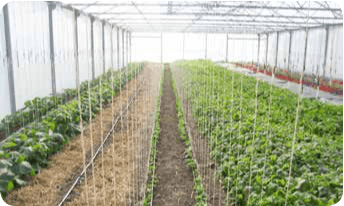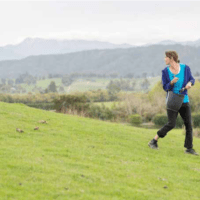Biodynamics in the Greenhouse
Harvest Article – Winter 2015
Growing vegetables using biodynamic methods can create gardens of extraordinary health and productivity. Living soil, nourished by regular applications of compost, careful plant rotations, and the biodynamic preparations, can steadily improve in structure and health. The daytime sun, nighttime moon, rain, wind and all the life within the garden offer challenges and opportunities for the grower to insert themselves within this seasonal dance and emerge with edible crops.

The Poraiti farm in Hohepa homes produce Demeter- certified vegetables from one hectare of intensive gardens. This is possible because the farm also acts as a ‘run-off’ for a sister dairy farm by raising replacement heifers and dry stock for meat. As the herd rotates through the paddocks, it periodically occupies an open ‘lounge yard’ where layers of waste hay or straw, garden residue and cut grass are enriched by their dung. This material builds up over several months and is then removed and assembled into large compost heaps which receive the preparations and are turned several times until ready for use. This compost is the vital ingredient in the management of our gardens and greenhouses.
Our large greenhouses can be imagined as quite foreign territories within this living world. Encased in plastic or glass, they are isolated from the outer garden world and are akin to a desert environment, where organic matter is depleted very quickly and plants are stretched beyond their normal habits to produce tremendous yields. A single tomato plant can produce 30 trusses in one season, compared to an acceptable 6 trusses in the field. This intensification requires us to use careful methods in our daily work, as greenhouse soils can quickly become overworked. Compost is applied annually at triple the rate of the outside gardens: one wheelbarrow load per 3 square metres per year at a minimum.

All of our methods have a common aim: to improve the soil, and to create a healthy environment for our food crops. Specific practices include:
- The soil is never left exposed for prolonged periods or allowed to dry out while being cultivated.
- Crop spacing is carefully considered to allow adequate airflow and sunlight. For instance, cucumbers and climbing beans can grow to 3 metres tall, so it is important that they are not grown next to each other but instead have a low-growing crop in between them
- Slow moving overhead fans keep air in circulation. Humid still air can create an unhelpful environment for unwelcome infections, such as powdery mildew.
- We prevent compaction by using walkways between the rows. We use wooden boards or old bread crates. An open soil structure can be destroyed in a very short time by regularly walking in the same place, so these spread the weight of our feet and enable us to walk on damp soil without damaging it.
- Green crops and grass leys are grown annually in order to allow the soil to rest and recover from intensive cultivation.
- We grow mustard crops – particularly after tomatoes – and then shred these with a weed eater / lawnmower combination, and quickly incorporate them into the soil and cover them with plastic for a few days. This process of bio-fumigation helps control any build up of unwanted parasitic fungi or bacteria. We apply preparation 500 and CPP immediately after the plastic is removed, in order to recolonise the soil in readiness for our next crop.
- Compost is applied to the growing green crops and incorporated naturally by the soil life. To avoid digging and inverting the soil, we cover the mown green crop with weed mat or black plastic and plant directly into the open soil once the green material has been absorbed
- Every greenhouse bed grows different crops in a pragmatic rotation, depending on our planting requirements. We grow tomatoes, cucumber, herbs, climbing beans, aubergine, capsicum and winter salad greens. Rotating these through the different houses, in between annual green crops, helps ensure that the soil retains a balanced structure, and antagonistic parasites are minimised.
- The full range of biodynamic preparations are a vital ingredient in our work, both in the soil and on the growing plant. We also use regular applications of horsetail tea (Equisitum arvense) with seaweed, both as a ‘liquid feed’ and as a preventative spray to counteract mildew on tomatoes. We have found this to be very effective.

In our large ‘twin skin’ greenhouse (which has two layers of plastic held apart by a small air pump), we produce several annual crops of tomatoes. This structure is well insulated, and the temperature is reasonably controllable, allowing us to harvest well into the early winter. Tomatoes have become a tricky crop to grow in the past few years, as the tomato and potato psyllid, Bactericera cockerelli, has become established in our region. We constantly monitor and remove damaged leaves, complementing this with biological controls, such as the use of a predator wasp (Aphidius spp) and regular foliar feeding to promote vigorous growth.
More traditional insect foes such as whitefly (Trialeurodes vaporariorum) are controlled using another parasitic wasp (Encarsia formosa).
The biodynamic greenhouse grower has be very alert to stay on top of all that is needed to manage this demanding environment in a sustainable way. The reward is the satisfaction of producing healthy Demeter-certified produce when outside crops are not available for harvesting.
Recommended Reading
Grotzke, Heinz. Biodynamic Greenhouse Management. BDFGA Inc., San Francisco, CA.
About this author
English born and Northern Irish raised, Andy Black has been working in biodynamics since 1984, when he completed an apprenticeship at Emerson College. He has been in New Zealand since 1986, and now manages the protected crops at Poraiti Farm. He lives in Haumoana with Ursula and extended family, who are all very keen that he continues to bring home vegetable



